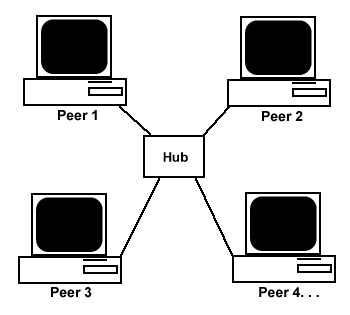Networks 101: Peer-To-Peer Networks
April 22, 2003
Author: Tom Jelen and Russ King
Editor's Note:
This article was originally published in September 2000. It was
updated in April 2003 by Michael Schrecker.
Networks can
allow computers, servers, and other devices to talk to each
other. There are a number of different types of networks, and
it's important to find the right one to fit your needs so that
you don't waste time and money with one that is too complex for
your needs, or one that doesn't fulfill your needs.
If you only need to share a printer or an Internet connection, a
client-server network (see article
Networking 101:
Client-Server Networks) might be overkill. Sometimes, a
simpler peer-to-peer network may be all you need. The diagram
below shows a simple peer-to-peer network:

As you can see from the diagram, in a peer-to-peer network there
are no dedicated servers or hierarchy among the computers. All
of the computers on the network handle security and
administration for themselves. The users must make the decisions
about who gets access to what. Beyond that there are more
similarities between the types of network than differences. All
of the computers must have network cards. You also use the same
cables, the same hubs and switches, and the same protocols as
you would with a client-server model. The only difference is
that there isn't a server. Since there isn't a server, there are
some things to think about before you go down the peer-to-peer
path.
Before Taking the Peer-to-Plunge
Peer-to-peer networks work remarkably well in certain
circumstances; however there are a few things to consider before
setting one up:
Size
Peer-to-peer networks are designed for connecting a small
number of computers. They tend to run into problems at around
10-15 computers.
Security
Security on a peer-to-peer network is not very powerful. So if
you have security concerns go for something you can control
(like a server). Because the users will be required to give
access to folders, they can choose to not require passwords.
This lack of hierarchy has a tremendous impact on the security
of your network and you will need adequate training for your
users to prevent problems.
Growth
If your organization is growing rapidly, it will usually
outgrow a peer-to-peer network very quickly. While a
peer-to-peer network may work fine for ten computers, it
probably won't for twenty.
Training
In a peer-to-peer network, the users handle administration.
This means that all the users need to be trained in how to
share files, folders, and printers. In a peer-to-peer network,
suddenly shutting down your computer can cause one of your
colleagues to be unable to print.
Hosting Resources
The last concern is that each computer that attaches to
another computer, whether for printing or for file sharing,
takes up system resources on the hosting computer. If the
drain becomes dramatic enough to slow down the host computer
then perhaps it is time to start thinking about a dedicated
server.
What Are Your Options?
If you've assessed your situation, and you've determined that a
peer-to-peer network is appropriate, the setup can be relatively
simple if you are using one of the common operating systems
available today.
Macintosh
The Macintosh has included peer-to-peer network capability in
its operating system for many years. You even have the option
to setup the network with phone lines and very simple
connectors. For more detailed information:
How to Create a Small Ethernet Network
A guide from Apple on setting up a small peer-to-peer
network.
Windows 95/98/ME/2000/XP
Windows 95, 98, ME, 2000, and XP all include the capacity for
peer-to-peer networking and can be set up with limited
hardware expenditures. For detailed information:
How to Use Windows 95 to Connect Computers on a Network
From Microsoft: a quick and easy guide to setting up a small
peer-to-peer network with Windows 95.
Creating a Peer-to-Peer Network with Windows 98
Microsoft instructions on setting up a peer-to-peer network
using Windows 98.
Creating a Peer-to-Peer Network with Windows 2000
Creating a Peer-to-Peer Network with Windows XP
Cross-Platform
It is possible to connect your Macs to your PC network - and
vice-versa. Here's how:
Connectivity between PC-Compatible and Macintosh Computers
on a Network
Information from Apple on connecting PCs to a Mac network.
MacWindows.com
The ultimate source for Macintosh-Windows compatibility and
networking information.
Conclusion
A peer-to-peer network is sometimes the perfect (and cheap)
solution for connecting the computers at a small nonprofit.
However, peer-to-peer networking has its limitations, and your
organization should tread with caution to avoid headaches
(security issues, hardware inadequacies, backup problems, etc.)
down the road.
|